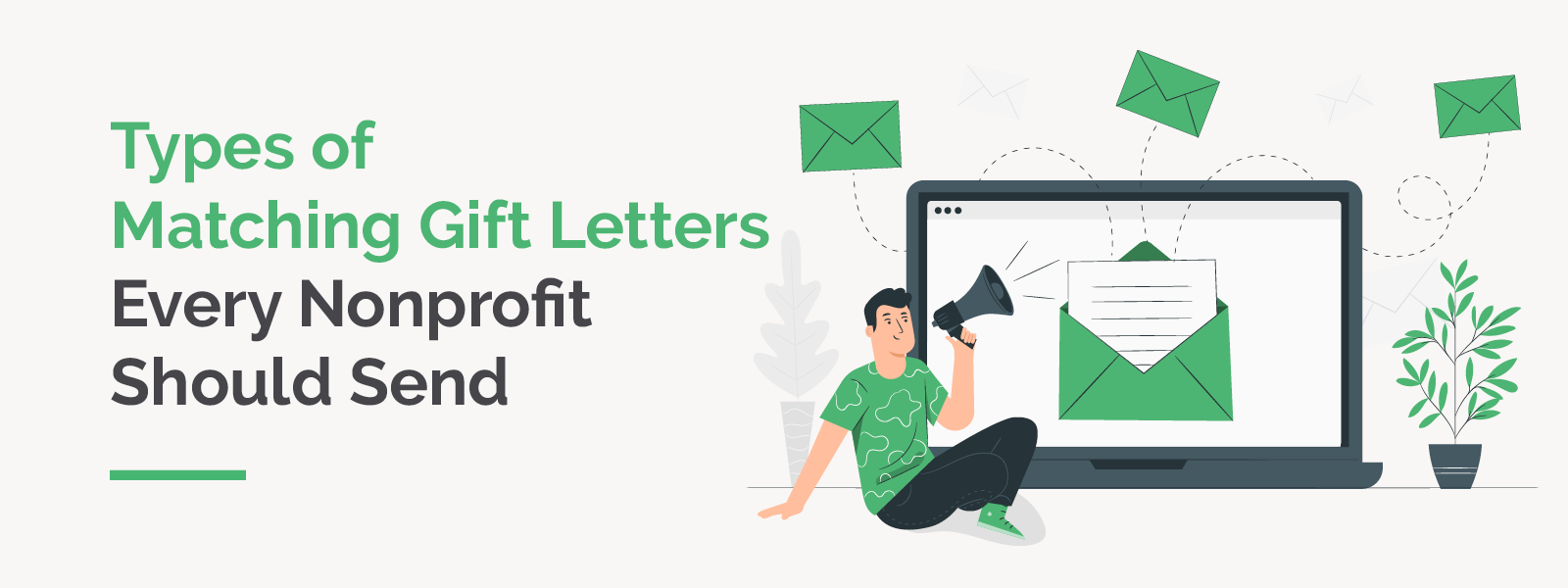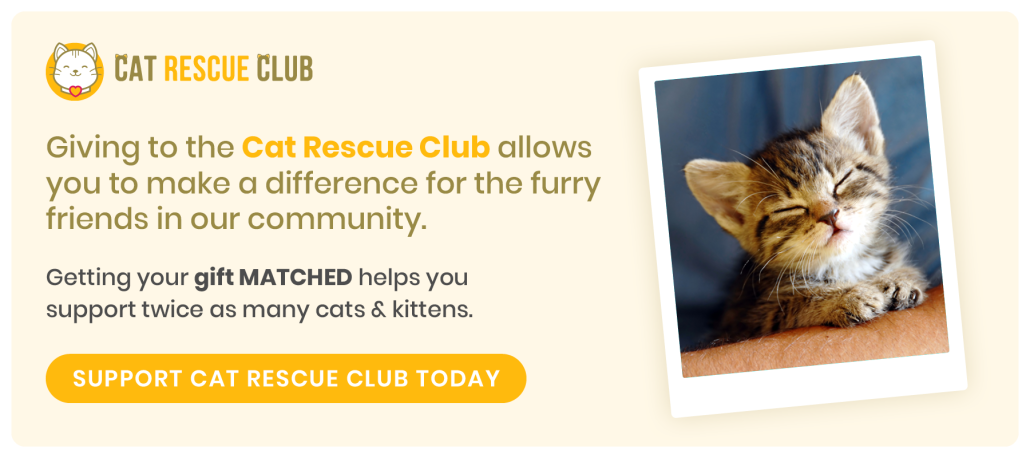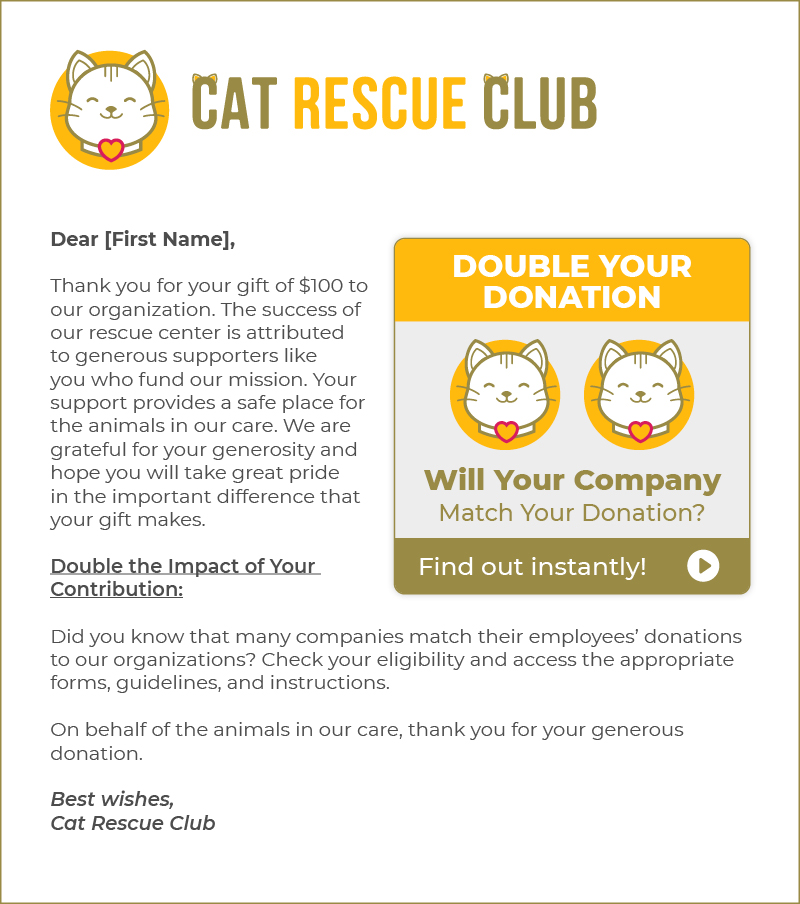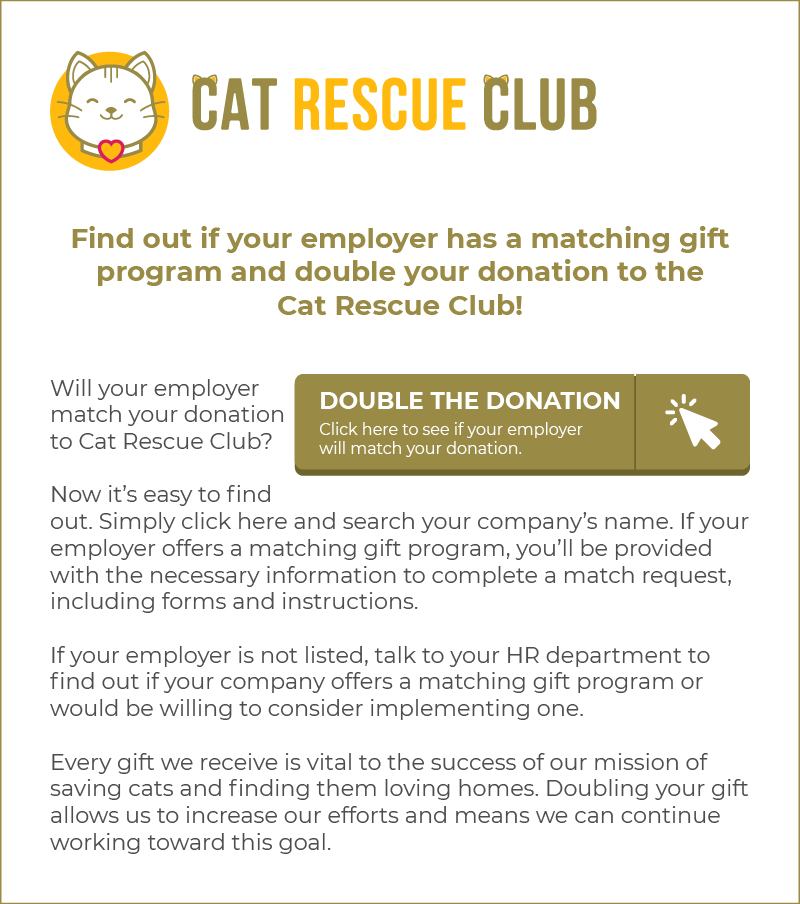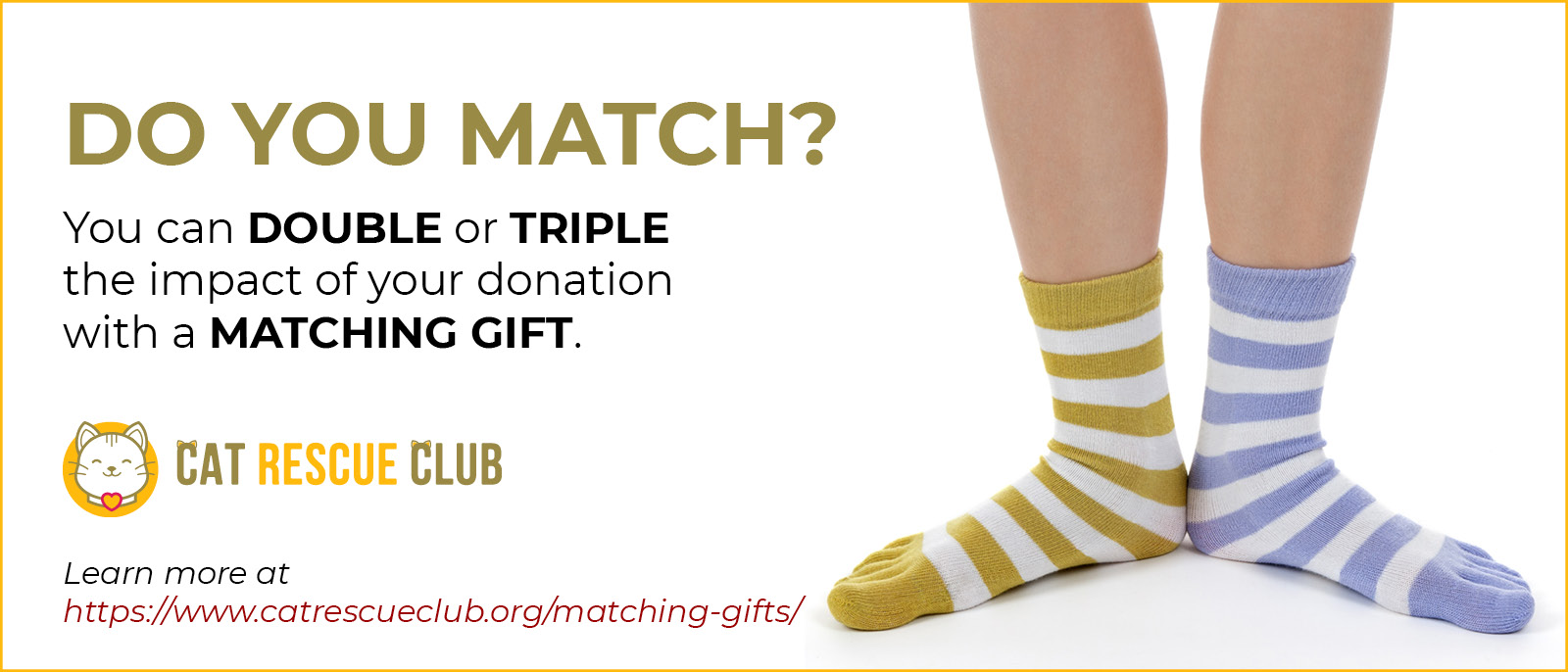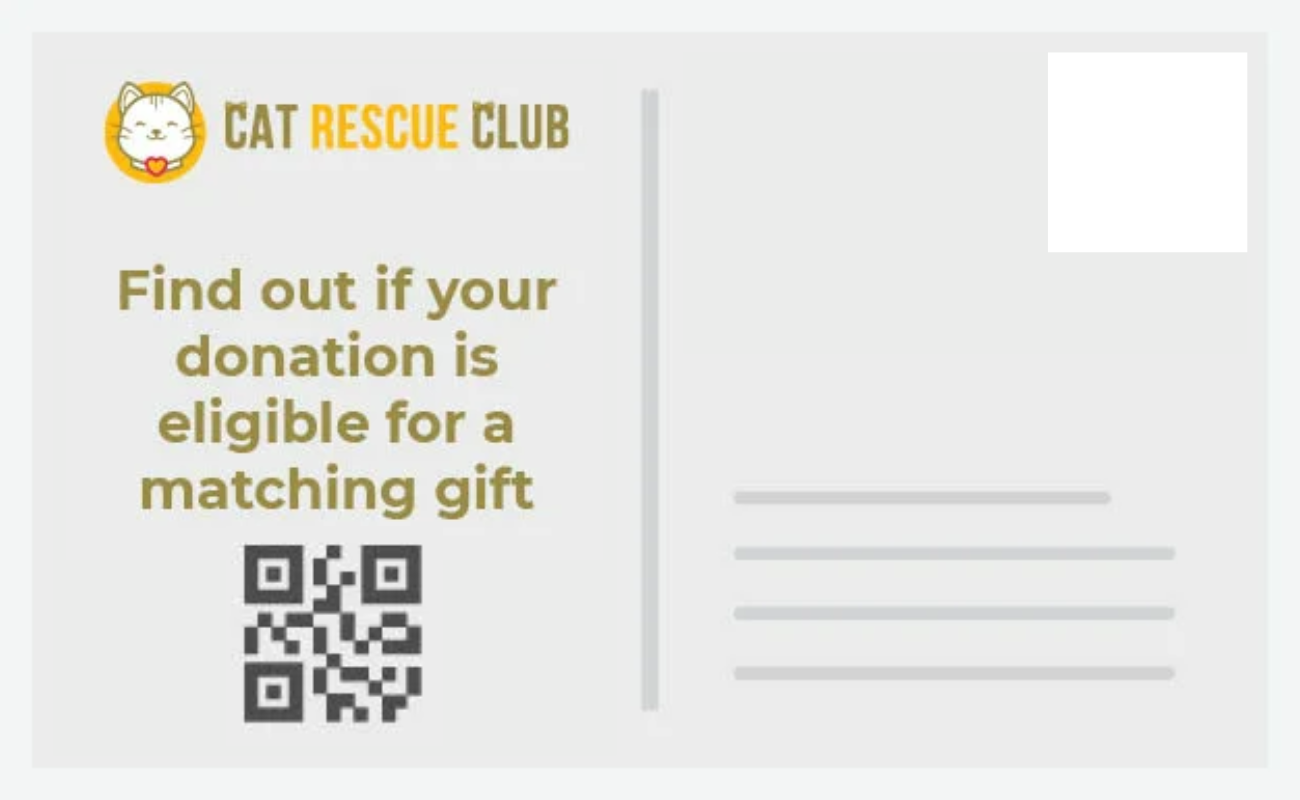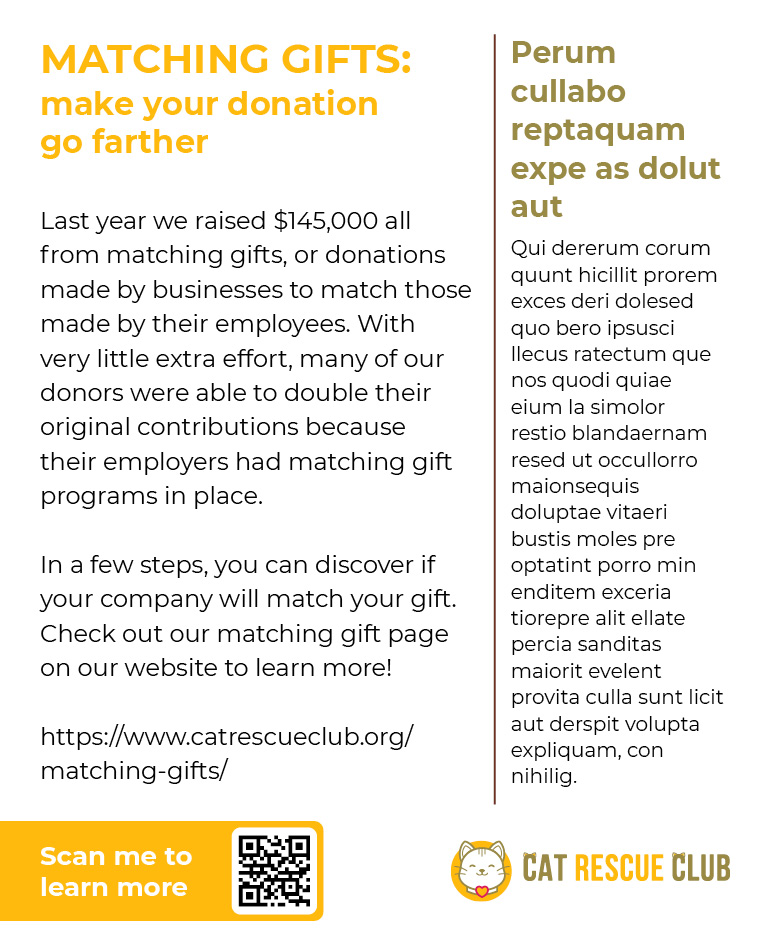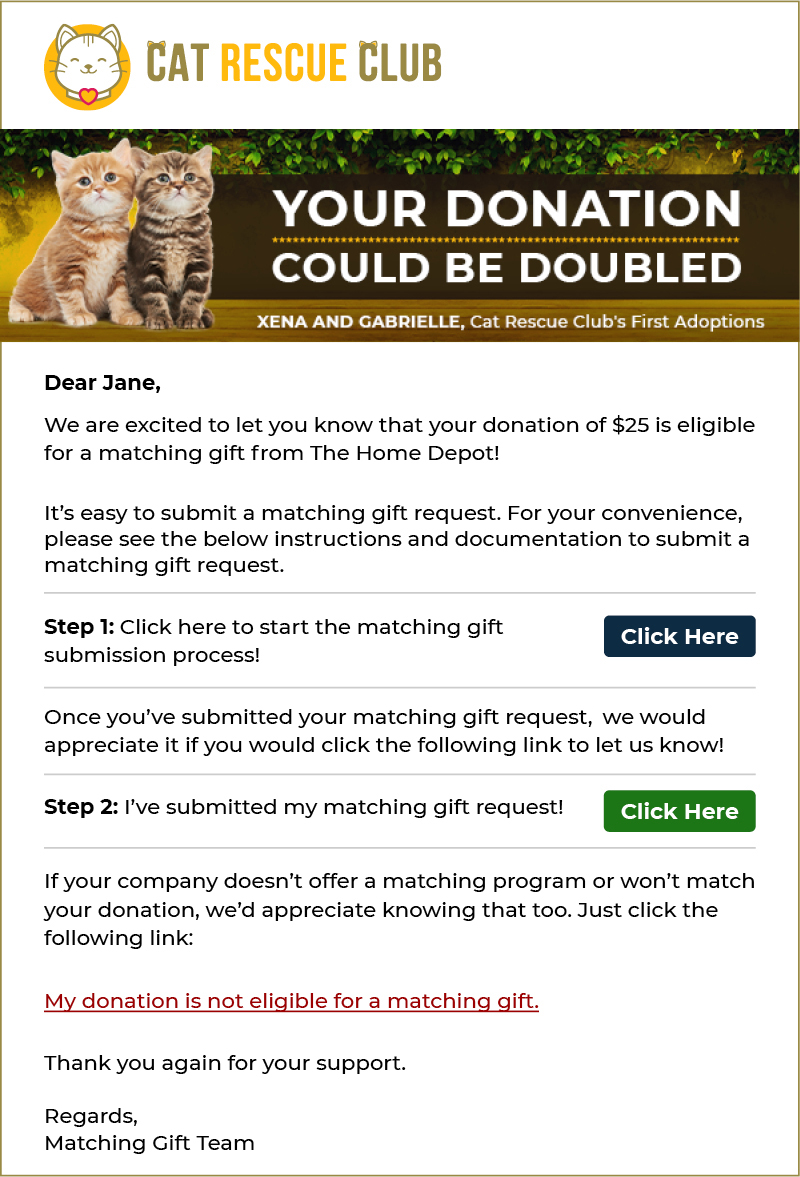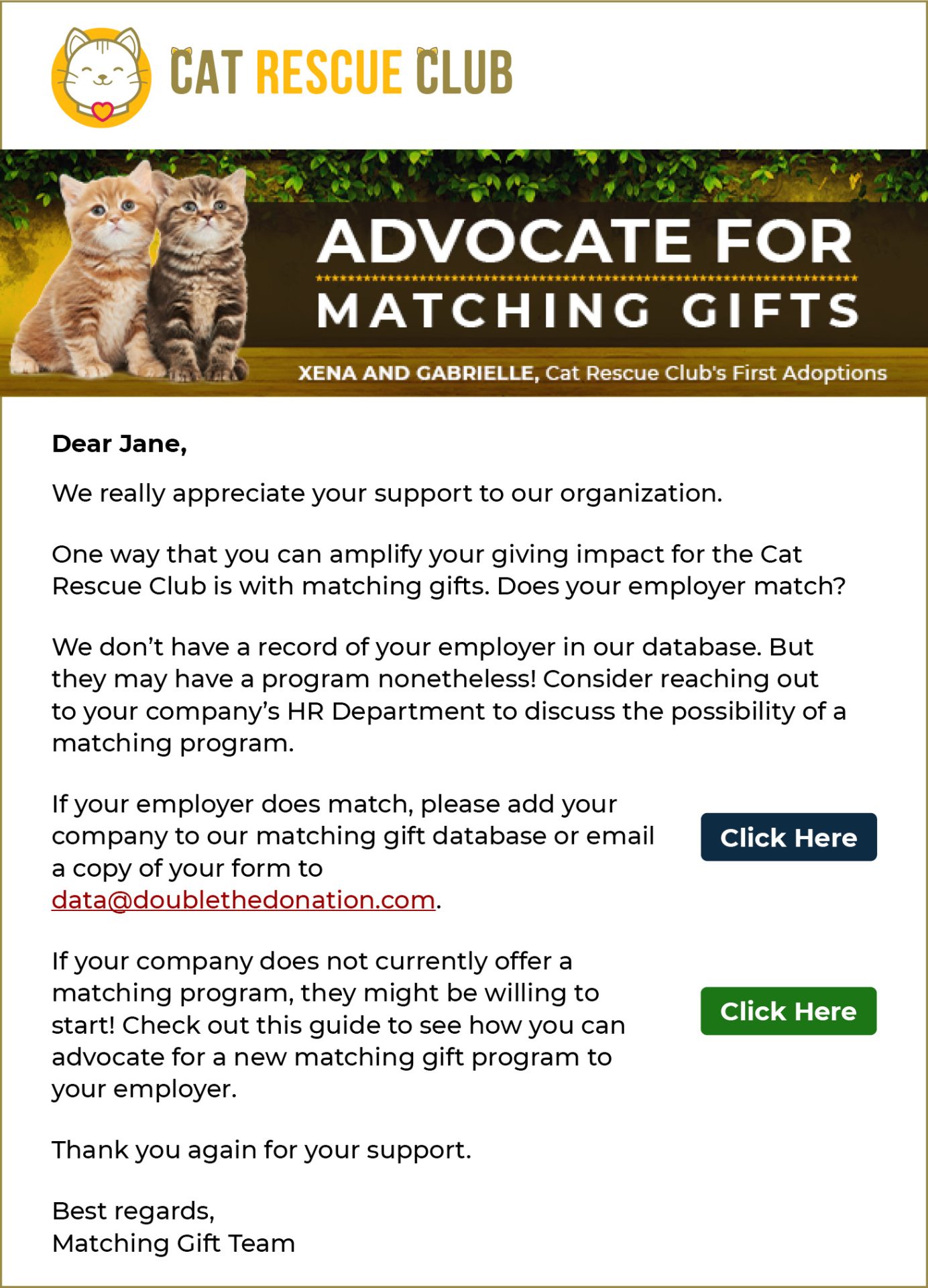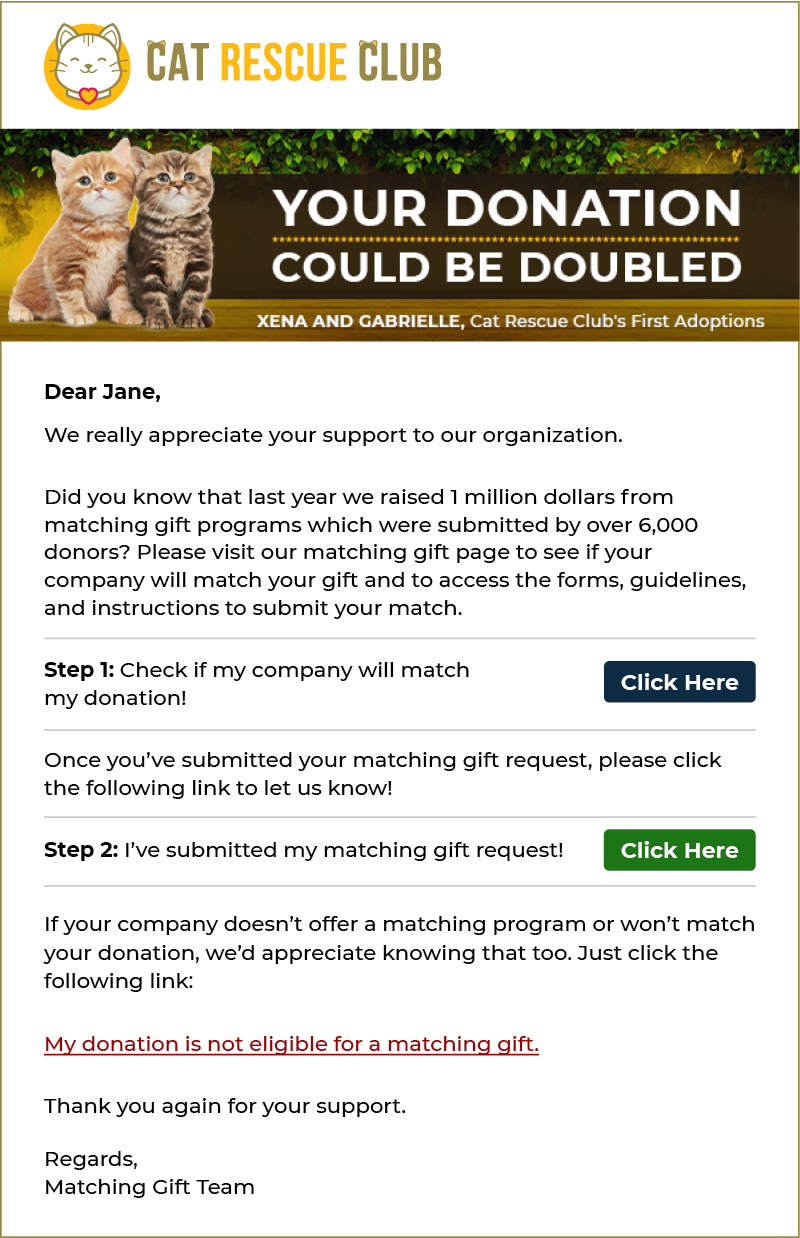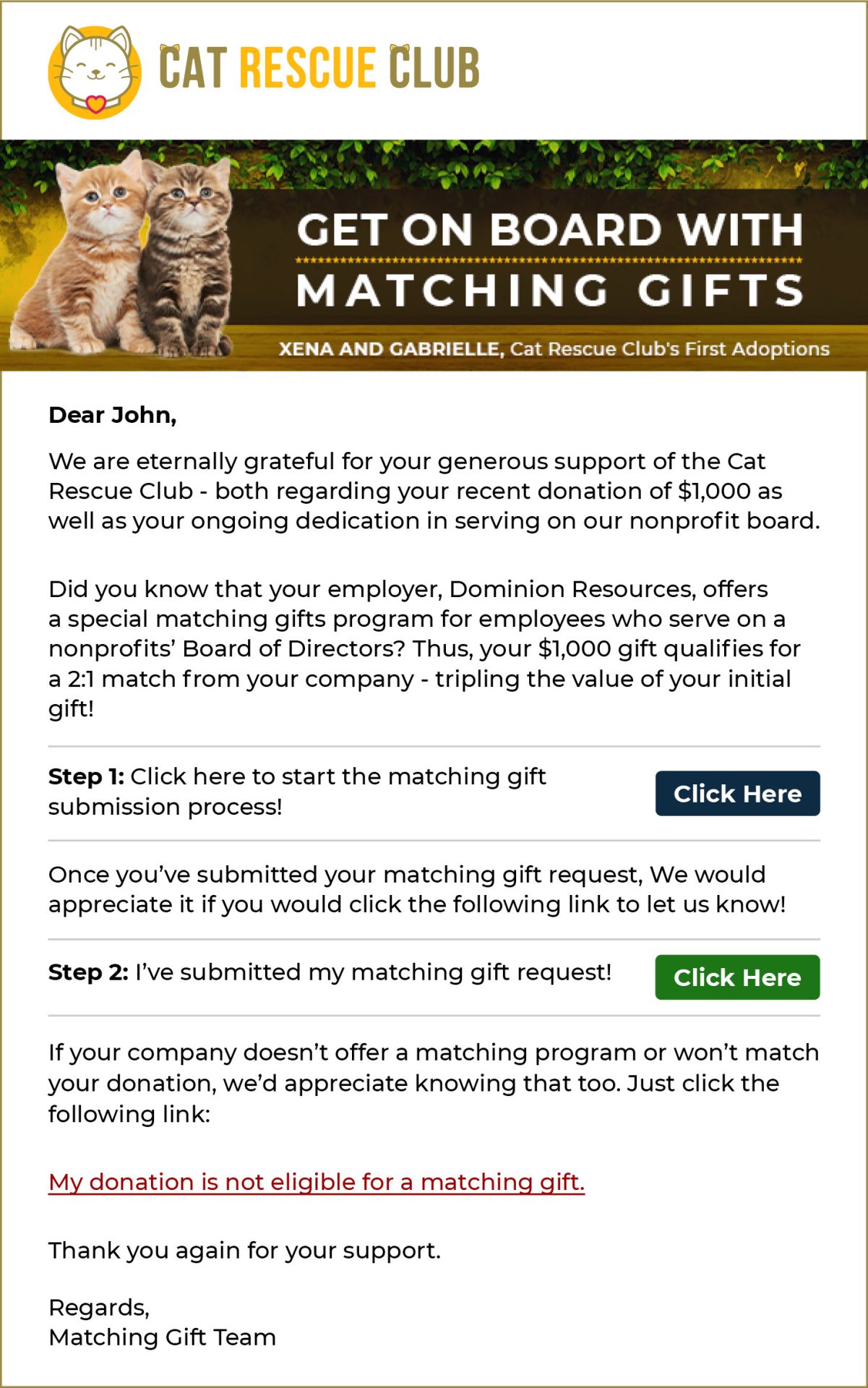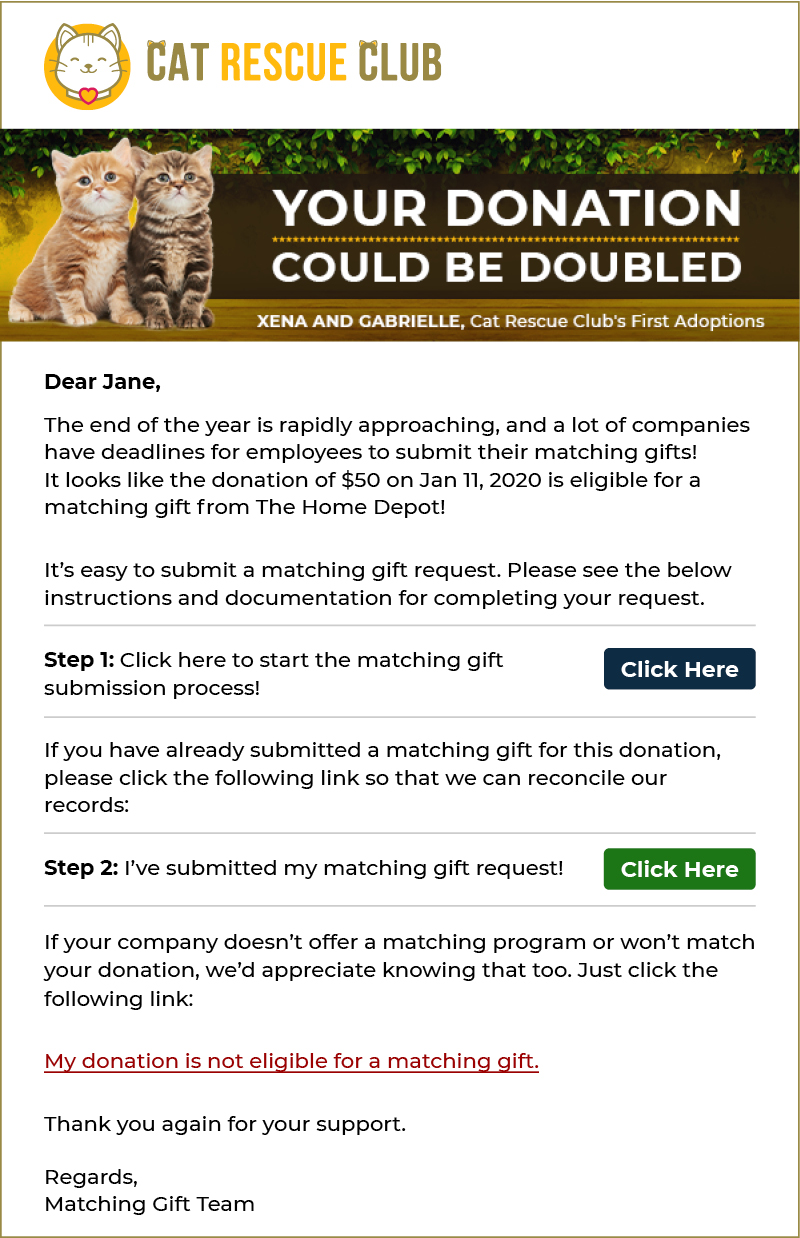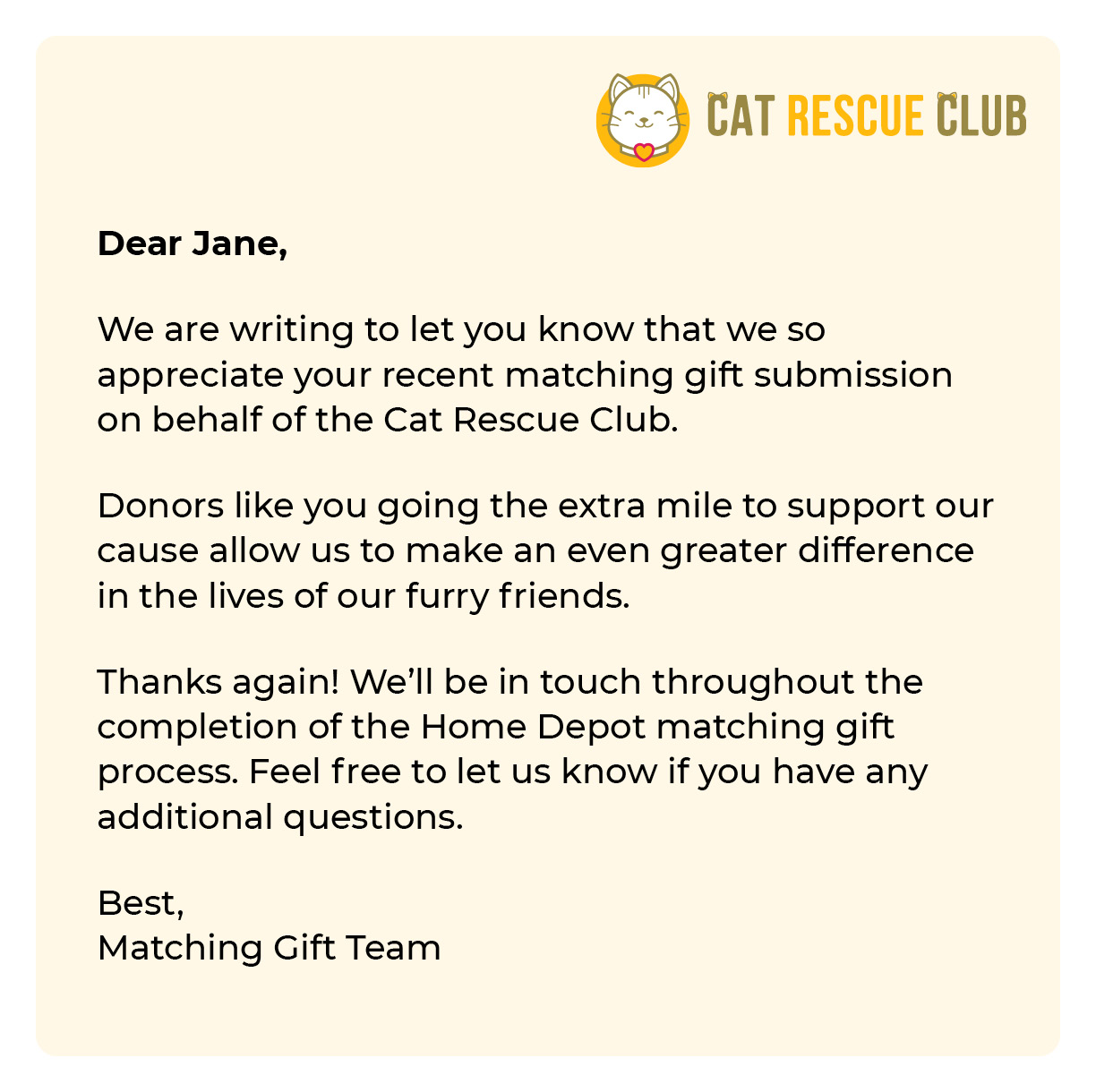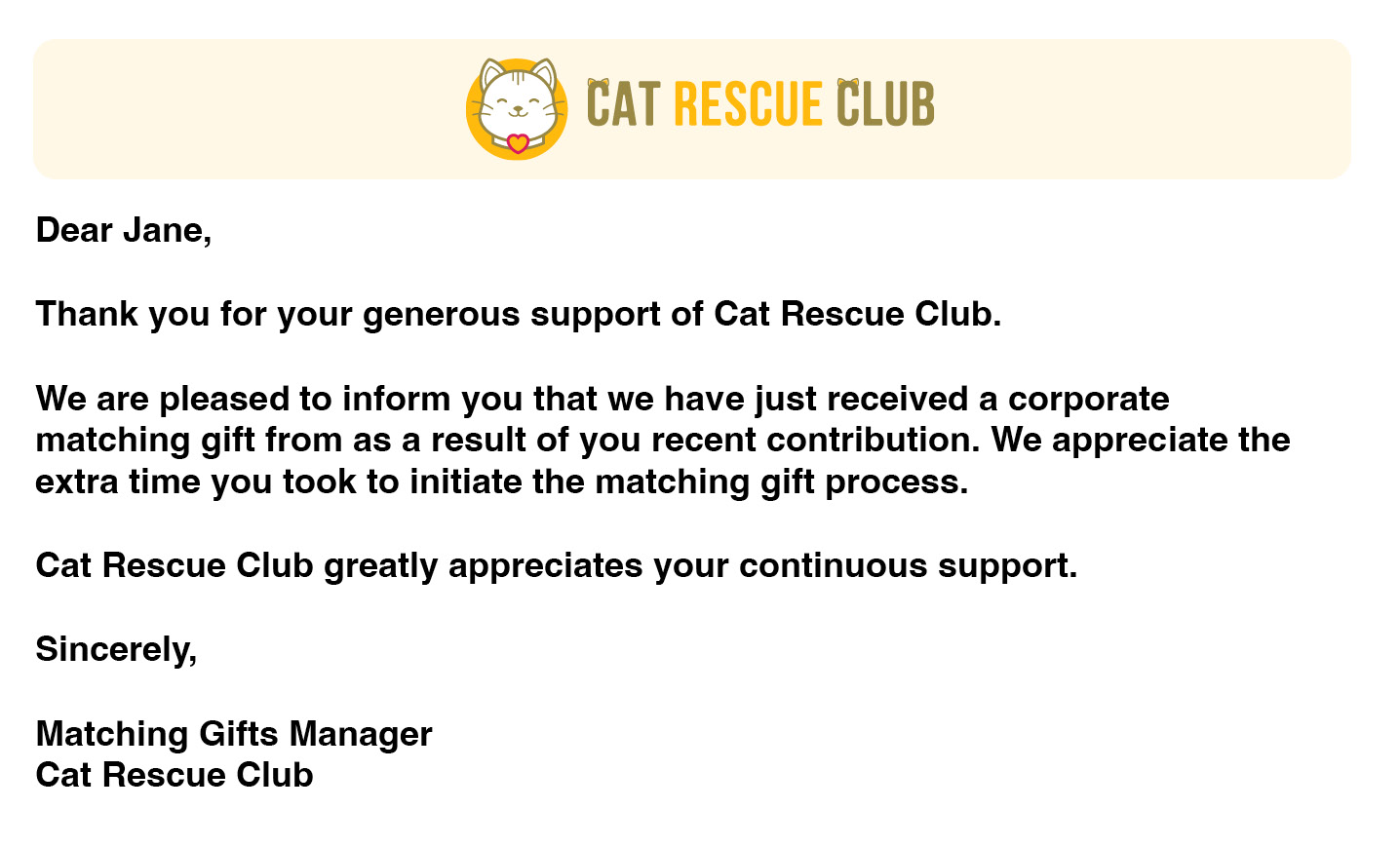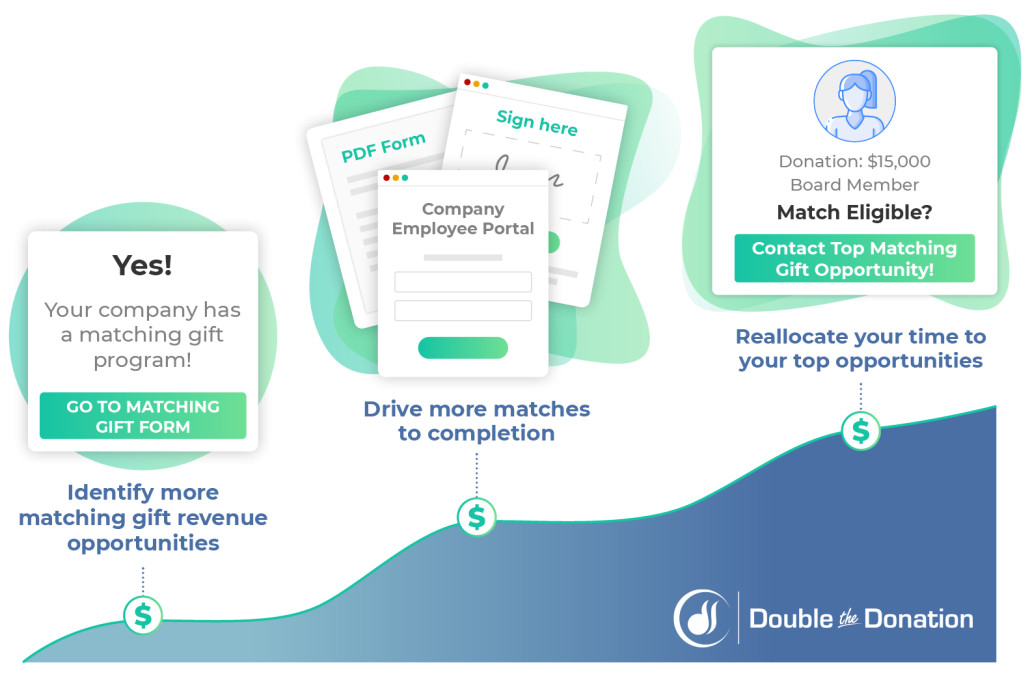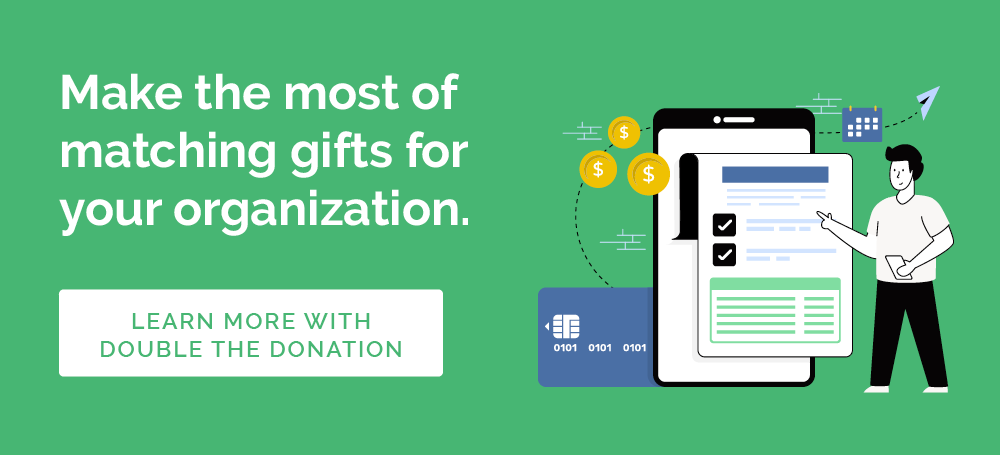14 Types of Matching Gift Letters Every Nonprofit Should Send
Corporate matching gifts have significant nonprofit fundraising potential, and one of the easiest, most effective ways to raise awareness for these programs is through personalized donor outreach. Whether through traditional or digital channels, smart matching gift letters can inform donors about the opportunities and encourage them to get involved.
And there are a wide variety of letters you can send to boost results.
To elevate your matching gift potential, we recommend incorporating these types of letters in your team’s donation-matching communications:
- Fundraising Appeal Matching Gift Letters
- Donation Acknowledgment Matching Gift Letters
- Matching Gift Emails
- Matching Gift Inserts
- Matching Gift Postcards
- Matching Gift Newsletters
- Eligible Donor Matching Gift Letters
- Ineligible Donor Matching Gift Letters
- Unknown Donor Matching Gift Letters
- Board Member Matching Gift Letters
- Peer-to-Peer Fundraiser Matching Gift Letters
- Giving Season or End-of-Year Matching Gift Letters
- Matching Gift Request Thank You Letters
- Completed Matching Gift Thank You Letters
In this guide, we’ll walk through the above kinds of matching gift letters, explaining how each can benefit your organization and its audience. Plus, we’ll share sample copy and inspiring examples that can bring your team’s messaging to the next level.
By providing donors with detailed information on how easy and important it is to submit matching gift requests to their employers, you can drive more matches to completion. Incorporating messaging that emphasizes these points can be particularly effective in your outreach.
Ready to maximize corporate and individual donations with well-crafted matching gift fundraising letters and use cases? Let’s get started!
Letter #1 – Fundraising Appeal Matching Gift Letters
As a nonprofit fundraiser, you surely understand the need to make your gift appeals stand out in your supporters’ mailboxes—whether physical or virtual.
Luckily, incorporating matching gift information in your fundraising requests can go a long way! In fact, our research indicates that 84% of supporters are more likely to donate if a match is being offered. And 1 in 3 would give a larger gift if matching is to be applied.
The result? A 71% increase in response rate and a 51% increase in average donation amount when matching is mentioned in fundraising appeals.
Check out this example to see it in action:
This type of matching gift letter should:
- Highlight the substantial impact that matching gifts can offer;
- Frame matching opportunities in terms of tangible mission-related programming when possible;
- Encourage donors to take part by contributing to your organization’s fundraising.
Get started with this free matching gift appeal letter template:
Dear [Donor’s Name],
We hope this letter finds you in good health and high spirits. As a valued supporter of [Nonprofit], we wanted to share an exciting opportunity that can magnify the impact of your generosity – matching gifts.
Did you know that many companies have matching gift programs in place to amplify their employees’ charitable contributions? It’s true! Through these programs, your giving has the potential to be doubled, tripled, or even quadrupled. This means that the gift you make today could have twice the impact, producing an even greater difference in the lives of those we serve.
To explore the potential of matching gifts and find out if your employer participates, please visit our donation page at [link] and use our embedded company search tool to receive step-by-step instructions after submitting your gift. We are committed to making the process as seamless as possible, ensuring that every dollar you contribute has the maximum impact.
Thank you for your continued generosity, advocacy, and belief in our mission. Together, let’s create a brighter tomorrow.
With heartfelt appreciation,
[Name]
[Title]
[Nonprofit]
Remember: your donors want to make a difference for the cause your nonprofit is pursuing. When presented with the opportunity to make their dollars go even further, supporters are often eager to get involved.
When to send: Whenever you organize a fundraising campaign that involves soliciting donations from supporters
Who to send to: All existing supporters and prospective donors
Why send: To increase awareness of matching gifts, elevate response rates, and make your appeals stand out
Letter #2 – Donation Acknowledgment Matching Gift Letters
Your communications after an individual supports your cause should help demonstrate your gratefulness for their giving. But did you know that your acknowledgment letters can also function as one of your first post-donation opportunities to promote matching gifts?
Donor thank-you letters (or emails!) can be written with customizable templates in which you insert a donor’s name, brand it to your organization, and provide a few other details in order to deliver a personal touch. For example, we recommend calling out specific gifts. Instead of a general “Thanks for the donation!” you can say, “We so appreciate your generous $100 contribution on May 5th, 2023.”
From there, consider plugging in a bit of information pertaining to matching gifts. It can be as simple as this: “Keep an eye out for ways to make your support go even further. We’ll send a separate email in the next few days regarding matching gifts.” In the meantime, you could even direct them to your dedicated matching gift web page to learn more!
Here’s a sample acknowledgment email complete with matching gift information:
This type of matching gift letter should:
- Thank the donor for their initial support of your organization;
- Inform the recipient that additional matching gift-related outreach will be sent soon;
- Encourage the individual to learn more about matching gift opportunities by exploring the nonprofit’s matching gift page.
Get started with this free matching gift donation acknowledgment letter template:
Dear [Donor’s Name],
On behalf of [Nonprofit], I want to express our sincerest gratitude for your recent donation of $[gift]. Your generous support enables us to continue [describe the impact of their contribution or the work your organization does].
But did you know that your donation has the potential to go even further? Many companies have matching gift programs in place, which means they can match their employees’ charitable contributions. By taking a few moments to seek a match from your employer, you have the power to double or even triple the impact of your recent gift.
To find out if your company participates, click here [link] to use our company search tool, and be on the lookout for more matching gift insights soon.
Warm regards,
[Name]
[Title]
[Nonprofit]
[Contact Information]
Thanking supporters is one of the major keys to maximizing donor retention. When you thank your donors in this way, you’re also extending a courtesy by giving them the chance to contribute more without reaching back into their own pockets.
Your donors want to help as much as possible, and you don’t want to leave easy money on the table. It’s a win-win!
When to send: Immediately after receiving a new donation
Who to send to: Recent donors
Why send: To thank individuals for their recent donations and provide information as to how they can amplify their giving impact
Keep in mind that this should not be a primary form of matching gift communication that you rely on to get the word out about the opportunity. Donation acknowledgments are often discarded without a thorough look, so you’ll want to incorporate other types of letters in your strategy as well.
Letter #3 – Matching Gift Emails
Nowadays, email is a popular outreach method for nonprofits looking to engage their supporters in the virtual realm. Thus, you’ll want to make the most of the channel by using it to promote matching gift opportunities.
Note: this section covers general matching gift emails that can be sent to all of your organization’s donors at various points year-round. Keep reading to learn about more targeted messaging that you might opt to trigger with donor- and company-specific insights below.
Take a look at this matching gift email you might send:
This type of matching gift letter should:
- Inspire interest from the start with an engaging subject line;
- Direct readers to the organization’s dedicated matching gift web page;
- Leverage specific and prominent calls to action that encourages donors to seek the opportunity;
- Emphasize the increased donation impact made possible through matching gift programs.
Get started with this free matching gift email template:
Subject: Double Your Impact with Matching Gifts!
Dear [Donor’s Name],
Did you know that many companies have matching gift programs in place to support their employees’ charitable giving? Through these programs, your donation can be matched dollar for dollar, doubling the impact of your generosity. Some companies even offer a 2:1 or 3:1 match, meaning your gift could have an even greater effect.
Seeking a matching gift is easy! Here’s how you can get started:
Check if your employer offers a matching gift program. You can do this by searching our matching gift database here [link] or by reaching out to your HR department.
Then, obtain and complete the necessary forms or information required by your employer. Be sure to follow any specific instructions provided by your company.
By taking a few moments to seek a match from your employer, you can double the impact of your donation, making an even greater difference in [Nonprofit]’s mission of [describe the specific impact of their contribution].
We are here to assist you throughout the matching gift process. If you have any questions or need assistance, please don’t hesitate to reach out to our matching gift coordinator at [contact information].
Thank you once again for your support and dedication to our cause. Together, we can create positive change and make a lasting impact.
With gratitude,
[Name]
[Title]
[Nonprofit]
To further streamline the matching process, consider equipping your nonprofit with a comprehensive matching gift database search tool. In that case, you can send supporters to the tool from your matching gift outreach and inspire them to see if their employer offers a program!
When to send: A few times throughout the year
Who to send to: All donors who have yet to submit match requests
Why send: To increase matching gift awareness and inspire donors to uncover their own eligibility
Letter #4 – Matching Gift Inserts
Direct mailings can go a long way toward enhancing donor engagement and getting your fundraising message in front of supporters. Since snail mail is on the pricier end of communications, you’ll likely want to do what you can to get your money’s worth out of the channel. And that means using your mail packages to promote matching gift opportunities.
However, you shouldn’t have to re-work your existing printed resources. Instead, we recommend creating new materials that can be included alongside your established fundraising letters. These inserts can simply be printed and slipped into your envelopes prior to sending. Then, you’re ready to go!
Here’s an example:
This type of matching gift letter should:
- Incorporate an eye-catching graphic to grab your recipients’ attention;
- Provide an easy way for donors to request additional information—such as an easy-to-type URL or scannable QR code;
- Be short, sweet, and to the point. Just a quick matching gift blurb will do!
Get started with this free matching gift insert template:
Double Your Impact with Matching Gifts!
Did you know that your donation to [Nonprofit] could be matched by your employer? Many companies have matching gift programs that can double or even triple your contribution.
It’s a simple process – scan the QR code (or go to the URL here: [link]) to learn more. By taking a few minutes to seek a match, you can multiply the value of your gift and help us continue our important work.
Thank you for considering a matching gift – together, we can make an even greater difference!
The good news is that paper inserts can be mailed along with almost any direct mail outreach. Consider sending them in newsletters, gift acknowledgments, event invitations, volunteer information, and more. Each communication will remind donors of the possibility of matching gifts, thus inspiring generosity and driving action.
When to send: Any time you send direct mail communications
Who to send to: All donors and prospects receiving direct mail outreach
Why send: To break through the digital clutter and drive matching gift awareness
Letter #5 – Matching Gift Postcards
If you’re looking to promote matching gifts via direct mail but want to take a more unique approach than a typical fundraising letter, consider sending a postcard instead.
To start, postcards have a friendly feel—like a note from a loved one who’s thinking of you. Consider incorporating them into your direct mail fundraising strategy to make your efforts stand out; specifically as a matching gift marketing tactic.
You’re sure to keep your organization (and its additional giving opportunities) at the forefront of the donor’s mind for a longer period of time. It might even end up on the recipient’s fridge!
Here’s what a matching gift postcard might look like:
This type of matching gift letter should:
- Grab your audience’s attention with a visually appealing design that is strategically branded to match your organization’s style;
- Include a clear and specific call to action for the recipient, such as determining their matching gift eligibility or submitting a request, if applicable;
- Keep any URLs short, sweet, and easy to type—or incorporate a scannable QR code.
Get started with this free matching gift postcard template:
Front
[Nonprofit logo]
Double Your Impact on [Nonprofit] with Matching Gifts!Back
Dear [Donor’s Name],
Thank you for your recent support of [Nonprofit]. Did you know that your donation could go twice as far? Scan the QR code below to find out how. [link to matching gifts page]
Thank you for considering a matching gift – your support makes a difference!
Sincerely,
[Name]
[Nonprofit]
[Contact Information]
Plus, you’ll always want to consider personalization. While you likely won’t have the time to handwrite every postcard, merely signing your name at the bottom can do wonders to let donors know that you took time out of your day to engage them.
Nowadays, we often refer to direct mail as ‘snail mail.’ But what it lacks in speed, it often makes up for in emotional impact!
When to send: A few days to a week after an individual has made a donation
Who to send to: High-value supporters who you’ve determined are likely to be eligible for a matching gift
Why send: To cut through the unnecessary obstacle of getting your fundraising letters opened in the first place
Top tip! If you’re looking to save on shipping costs, a digital postcard can make your efforts stand out as well. Consider sending a fundraising eCard that highlights matching gift opportunities and directs donors to your matching gift web page to learn more.
Letter #6 – Matching Gift Newsletters
Without a promotional strategy in place, more often than not, potential and current donors won’t know about matching gift opportunities–let alone what they entail. A good remedy for this is to include it in one of your most valuable marketing resources: your newsletter.
A nonprofit newsletter is a popular way for supporters to stay up to date on current happenings at an organization they support. This regular publication may be a physical resource sent through the mail or a digital one that makes its way to your audience’s email inboxes. Regardless, it likely provides details on upcoming events, ways to get involved, and more. And it’s perfect for matching gift information!
Check out this sample matching gift newsletter:
This type of matching gift letter should:
- Make matching gifts a regular feature in newsletters sent to donors and prospects;
- Incorporate an overview of the fundamentals of matching gift programs;
- Provide step-by-step instructions for donors interested in getting involved in the initiatives;
- Share real examples of ways your organization has benefited from matching gifts in the past.
Get started with this free matching gift newsletter template:
Double Your Fundraising Power With Matching Gifts
Many companies have matching gift programs that can double or even triple your donations, allowing you to make an even greater difference in the causes you care about.
Here’s how it works: When you donate to [Nonprofit], you can easily check if your employer offers a matching gift program. With a few additional steps, you can unlock new sources of funds that directly benefit our organization.
For example, a $100 contribution can produce over $200 worth of value, thanks to your employer’s workplace giving initiative. This additional funding allows us to expand our programs, reach more individuals in need, and create lasting positive change in our community.
We encourage you to explore the matching gift opportunities available to you. Together, we can make an even greater impact on our mission.
Depending on your needs, you may decide to include a section about matching gifts within a larger publication or devote an entire edition just to corporate gift-matching. Other enticing topics to cover may include a list of popular matching gift companies, facts and figures relating to your nonprofit’s prior matching success, research demonstrating the prevalence of such programs, and more.
When to send: Once or twice throughout the year
Who to send to: Donors, volunteers, prospects, and others on your nonprofit’s newsletter mailing list
Why send: To inform donors about the prevalence of matching gift opportunities and how they can get involved
Letter #7 – Eligible Donor Matching Gift Letters
An eligible donor matching gift letter is a specific type of outreach sent only to supporters who you’ve identified as being likely eligible for a corporate match through their employer. This targeted messaging typically aims to inform donors about not only the existence of matching gift programs in a general sense but also to provide company-specific details pertaining to their own employer.
Plus, it will often include personalized instructions on how the recipient can initiate the request process now that they’ve been deemed eligible.
If you’ve determined that a donor works for a matching gift company, you’ll want to send a matching gift letter like this:
This matching gift letter should:
- Address the donor by name and acknowledge their initial gift amount;
- Encourage the reader to submit their matching gift request;
- Provide direct links to match submission forms or online portals for the individual’s employing company;
- Ask the supporter to notify the organization once they’ve completed their request.
Get started with this free matching gift eligible donor letter template:
Dear [Donor’s Name],
We are pleased to inform you that your recent donation of $[gift] qualifies for a matching gift from your employer, [Company]. Requesting your match is easy, and we’ve provided you with the forms and instructions you need to complete the process.
Step 1: Click here to access [Company]’s matching gift forms. Fill out the online form and submit it to your employer!
Step 2: After completing your request, please click this link to let us know that it’s been submitted.
On behalf of the whole team at [Nonprofit], we are SO grateful for your continued support of our mission. We hope you take the opportunity to amplify your giving impact with a corporate match!
If you have any questions throughout the process, feel free to reach out to our matching gift coordinator at [contact information].
Best regards,
[Name]
[Title]
[Nonprofit]
If you’re looking for a more efficient way to uncover match-eligible donors and trigger personalized matching gift letters like these, consider investing in an automation tool like Double the Donation Matching.
The Double the Donation platform scans information donors provide during the giving process to determine likely eligibility, sending personalized and actionable email streams that drive more qualifying matches to completion.
When to send: Within 24 hours of an individual making a donation to your nonprofit
Who to send to: Donors who you’ve identified as likely eligible for a matching gift program through available employment information
Why send: To provide company-specific matching gift program guidelines and links to submission forms
Letter #8 – Ineligible Donor Matching Gift Letters
On the other hand, an ineligible donor matching gift letter is a type of outreach that informs the recipient that, according to the nonprofit’s records, they likely do not qualify for a matching gift from their employer. However, it’s vital to keep a positive approach, encouraging donors to consider amplifying their support for the organization in other ways.
Check out this sample matching gift letter you might send to a donor you’ve marked as likely ineligible for a match:
This matching gift letter should:
- Thank the donor for their initial support of the organization;
- Encourage the reader to confirm with their employer the existence (or lack thereof) of a corporate matching gift program;
- Inspire the individual to consider advocating for their employer regarding the establishment of a new matching gift program;
- Include or link to additional resources that can aid an employee in championing a matching gift program.
Get started with this free matching gift ineligible donor template:
Dear [Donor’s Name],
We really appreciate your recent donation to our organization.
One way that you can amplify your giving impact for [Nonprofit] is with matching gifts. Does your employer match?
We don’t have a record of your employer in our database. But they may have a program nonetheless! Consider reaching out to your company’s HR Department to discuss the possibility of a matching program.
If your employer does match, please add your company to our matching gift database or email a copy of your form to data@doublethedonation.com.
If your company does not currently offer a matching program, they might be willing to start! Check out this guide to see how you can advocate for a new matching gift program to your employer.
Thank you again for your support.
Best regards,
Matching Gift Team[Nonprofit]
You never know–an ineligible donor may be just the person to influence a brand-new matching initiative. And your communications to these individuals can go a long way toward providing updated data points, deepening engagement opportunities, corporate partnership potential, and more.
When to send: Within 24 hours of an individual making a donation to your nonprofit
Who to send to: Donors who have indicated that they work for a company that does not offer a matching gift program
Why send: To encourage such supporters to double-check for the existence of a matching program and provide resources to aid in new program advocacy
Letter #9 – Unknown Donor Matching Gift Letters
After giving, there’s a third category in which donors may be placed–and that is unknown eligibility. Unknown donor matching gift letters are those sent to that segment.
A donor may be sorted into this category based on a few reasons. First, an individual may have simply completed their initial gift without providing their employment details. In this case, you can’t know if a donor will qualify for a matching gift if you don’t know where they work.
On the other hand, another donor may be marked as “unknown eligibility” if they did provide their current employer, but your organization lacks information regarding the availability of the company’s matching gift programs.
If a donor’s eligibility is unknown, consider sending a letter like this one:
This matching gift letter should:
- Thank the donor for their initial contribution;
- Encourage the individual to look up their employer using the provided company search tool;
- Inspire the reader to take the applicable next steps depending on their determined eligibility status;
- Ask the supporter to let the sender know whether their employer offers a matching program and/or when they’ve submitted their match request.
Get started with this free matching gift unknown donor template:
Dear [Donor’s Name],
Warm greetings from [Nonprofit]! We hope this letter finds you in good health and high spirits. We are writing to express our deepest gratitude for your recent donation to support our cause. Your generosity is making a significant impact on the lives of those we serve.
We wanted to take this opportunity to inform you about an incredible opportunity to increase the impact of your contribution – matching gifts. Many companies offer matching gift programs that can double or even triple the value of your donation.
To find out if you qualify for such a match, please click here to search for your employer in our matching gift database lookup tool! It’s quick and easy, and can even provide you with the forms you need to complete your match in seconds.
Then, once you’ve submitted your matching gift request, click here to let us know.
Thank you again for your ongoing support of [Nonprofit] and our mission.
Sincerely,
[Name]
[Nonprofit]
Overall, this type of outreach should be used to drive donors further down the funnel. Whether they do or do not ultimately qualify for matching gifts, following the instructions provided in the letter allows them to provide the sending organization with additional information that can help guide further efforts.
When to send: Within 24 hours of an individual making a donation to your nonprofit
Who to send to: Donors for which you do not have current employment information to determine eligibility or those whose employers lack updated matching gift guidelines
Why send: To encourage donors to provide up-to-date employment data and uncover their matching gift eligibility
Letter #10 – Board Member Matching Gift Letters
You know your board members are some of your most valuable supporters. And they often come with lucrative matching opportunities, as well!
Board member matching gift letters are a type of communication sent exclusively to your nonprofit’s board of directors. Most often, these messages will be sent following a recent donation, encouraging the recipient to pursue a matching gift from their employer. This allows board members to take a more active role in fundraising for your nonprofit, which is a common challenge identified in board assessments.
After all, many companies offer exceptionally generous matching gift programs (which often incorporate higher donation ratios and maximums) for even greater corporate matching impact when an employee serves on a nonprofit board.
Here’s an example of a board member matching gift letter:
This matching gift letter should:
- Address the donor/board member by name and thank them for their recent contribution to the organization;
- Explicitly acknowledge the individual’s status as a member of the nonprofit’s board of directors;
- Encourage the reader to submit a board member match request to their company;
- Provide direct links to match submission forms or online portals for the individual’s employing company;
- Ask the individual to notify the organization once they’ve completed their request.
Get started with this free matching gift board letter template:
Get on Board With Matching Gifts!
Dear [Donor’s Name],
We are eternally grateful for your generous support of [Nonprofit] – both regarding your recent donation of $1,000 as well as your ongoing dedication in serving on our nonprofit board.
Did you know that your employer, [Company], offers a special matching gifts program for employees who serve on a nonprofits’ Board of Directors? Thus, your $[gift] donation qualifies for a [matching gift ratio] match from your company – multiplying the value of your initial gift!
Requesting your match is easy, and we’ve provided you with the forms and instructions you need to complete the process.
Step 1: Click here to access [Company]’s matching gift forms. Fill out the online form and submit it to your employer!
Step 2: After completing your request, please click this link to let us know that it’s been submitted.
On behalf of the whole team at [Nonprofit], we are SO grateful for your continued support of our mission. We hope you take the opportunity to amplify your giving impact with a corporate match!
If you have any questions throughout the process, feel free to reach out to our matching gift coordinator at [contact information].
Warmly,
[Name]
[Nonprofit]
Keep in mind that your board members have already shown great dedication toward your cause. Otherwise, they wouldn’t be on the board in the first place. Take the opportunity to promote matching gift programs for qualifying board members–especially if you know that their employer is one that provides a special match initiative.
When to send: Soon after receiving a donation from a board member
Who to send to: Donors who currently serve on your organization’s board of directors or board members who aren’t currently giving
Why send: To inform board members that many companies offer unique matching gift programs when their employees serve on a nonprofit’s board
Letter #11 – Peer-to-Peer Fundraiser Matching Gift Letters
Even among those who’ve been informed about traditional donation match programs, many are still unaware that other companies offer fundraising match programs. The difference? Donation matching involves an individual requesting that their employer matches a gift they personally contributed to a nonprofit. Fundraising matches, on the other hand, encompass a company matching all the funds an employee raises on a nonprofit’s behalf—even those not made by the company’s employees themselves.
So if you’ve recently hosted a peer-based fundraising event (such as a run/walk/ride), a peer-to-peer matching gift letter can be an excellent follow-up for eligible individuals.
Here’s a sample matching gift letter you might send to a recent peer-to-peer fundraiser:
This matching gift letter should:
- Acknowledge the volunteer fundraiser by name and recognize their total amount of fulfilled pledges from the P2P campaign;
- Encourage the reader to submit a fundraising match request to their employer;
- Provide direct links to match submission forms or online portals for the individual’s employing company;
- Ask the supporter to notify the organization once they’ve completed their request.
Get started with this free matching gift peer-to-peer fundraiser template:
Your Pledges Could Be DOUBLED!
Dear [Donor’s Name],
We are so grateful that you’ve supported [Nonprofit] by taking on a peer fundraising role in our recent campaign.
Did you know that your employer, [Company], offers a special matching gift program in which it offers to match the fulfilled pledges an employee collects on behalf of a nonprofit cause? That means the $[total collected pledges] you raised for our [campaign name] is eligible to be multiplied!
Requesting your match is easy, and we’ve provided you with the forms and instructions you need to complete the process.
Step 1: Click here to access [Company]’s matching gift forms. Fill out the online form and submit it to your employer!
Step 2: After completing your request, please click this link to let us know that it’s been submitted.
On behalf of the whole team at [Nonprofit], we are SO grateful for your continued support of our mission. We hope you take the opportunity to amplify your giving impact with a corporate match!
If you have any questions throughout the process, feel free to reach out to our matching gift coordinator at [contact information].
Best wishes,
Matching Gift Team
[Nonprofit]
Peer fundraising initiatives often produce significantly higher funding amounts than a single donation. Fundraising match letters can help bring that success to the next level!
When to send: In the days or weeks following the conclusion of a peer-to-peer fundraising campaign
Who to send to: Peer-to-peer fundraising volunteers who have recently collected donations on your organization’s behalf
Why send: To inform peer-to-peer fundraisers that many companies offer unique matching gift programs that allow employees to request corporate matching for their total fundraising amounts
Letter #12 – Giving Season or End-of-Year Matching Gift Letters
Donors often increase their charitable giving at the end of the year. This is when individuals are most aware of their finances and how much they have left to give. Plus, the holiday season tends to bring out an increase in generosity.
Because of this, many nonprofits make their big pushes for donations during this end-of-the-year giving season, such as through matching donation challenges. This is also an excellent time to pursue corporate matching gifts.
And an automation platform like Double the Donation can help! That’s why Double the Donation offers a dedicated year-end email stream that you can use to contact donors about the donations they’ve already made during the year.
Here’s what a year-end matching gift email can look like:
This matching gift letter should:
- Be personalized to the donor;
- Include the donation amount and date;
- Provide pertinent information about the donor’s employer and their matching gift eligibility;
- Establish urgency by reminding the donor that many companies close their request windows at the end of the year in which the donation was made;
- Leverage clear calls-to-action that encourage donors to kickstart the matching gift process.
Get started with this free matching gift end-of-year fundraising letter template:
Dear [Donor’s Name],
It’s not too late! Did you know that you can still request a matching gift for your donation of $[gift] made on [donation date]?
Thousands of companies have matching gift programs in place that can significantly increase the value of employees’ donations. However, it’s important to note that many employers close their matching gift request windows at the end of the calendar year in which a gift is made.
So that means the time is now to complete the matching gift process and amplify your support of [Nonprofit] and its mission. Luckily, a submission is easy, and we’ve provided you with the forms and instructions you need to finalize your match.
Step 1: Click here to access [Company]’s matching gift forms. Fill out the online form and submit it to your employer!
Step 2: After completing your request, please click this link to let us know that it’s been submitted.
If you have any questions throughout the process, feel free to reach out to our matching gift coordinator at [contact information].
Season’s greetings,
Matching Gift Team
[Nonprofit]
Many people have already donated for the year, and the giving season is an ideal opportunity to remind supporters how they can do more to help your cause.
When to send: The end of the calendar year
Who to send to: Match-eligible donors who have not indicated that they’ve submitted their matching gift request
Why send: To remind donors about matching gifts and encourage submissions while their gifts still qualify
Letter #13 – Matching Gift Request Thank You Letters
We’ve previously recommended that organizations employing matching gift letters to drive match submissions should encourage eligible donors to let them know when they’ve completed their requests. This enables easier tracking through the matching gift lifecycle and better forecasting (and, thus, budgeting) for incoming matches.
However, it also provides an additional opportunity to engage with your matching gift donors. And that’s where matching gift request acknowledgment (or thank-you) letters come in!
Upon being notified of a recent matching gift submission, consider sending a matching gift thank you note like this:
This matching gift letter should:
- Let the recipient know that they’ve been notified of the individual’s recent matching gift request;
- Thank the matching gift donor for their above-and-beyond support of the organization;
- Reiterate the vast benefits of matching gifts on the nonprofit’s overarching mission.
Get started with this free matching gift request thank-you letter template:
Dear [Donor’s Name],
We are writing to let you know that we so appreciate your recent matching gift submission on behalf of [Nonprofit].
Donors like you going the extra mile to support our cause allow us to make an even greater difference for our mission.
Thanks again! We’ll be in touch throughout the completion of the [Company] matching gift process. Feel free to let us know if you have any additional questions.
Best,
Matching Gift Team[Nonprofit]
Depending on the employing company’s submission requirements, you might choose to inform the donor that you’ll begin your part of the matching gift process (such as filling out a separate form or confirming that the initial gift was made).
When to send: Within 24 hours of a matching gift submission notification
Who to send to: Donors who have recently indicated that they completed their employer’s matching gift request process
Why send: To confirm that your organization was notified of a submitted matching gift request by a donor
Letter #14 – Completed Matching Gift Thank You Letters
Our last recommended matching gift letter is another thank-you. But this time, it’s sent after a matching gift is completed by the company.
This letter allows your organization to reiterate your gratitude for the individual going the extra mile, which has resulted in double (or perhaps triple!) the funding for your cause. Plus, it allows you to close the loop, ensuring the donor understands their match was successful.
After you’ve received a completed match from a donor’s employer, send a final acknowledgment like this one:
This matching gift letter should:
- Thank the donor once again for their willingness to pursue a matching gift on your nonprofit’s behalf;
- Acknowledge that the company match has been successfully received and processed.
Get started with this free completed matching gift thank-you letter template:
[Donor],
We’re SO excited to let you know that we recently received the matching gift funds from your employer, [Company]. Once again, we thank you for all your support.
And please consider requesting a match again if you decide to make another gift in the future!
Much appreciation,
[Name]
Matching Gift Team
[Nonprofit]
You can also use this matching gift letter to encourage donors to keep their employer’s matching program in mind in regard to future engagement opportunities. After all, you now know for certain that the individual qualifies for corporate matching. Make sure to set your team up for ongoing match success but encourage future participation as well!
When to send: In the days after you receive a completed matching donation from an individual’s employer
Who to send to: Donors whose matching gifts were recently fulfilled by their employing companies
Why send: To wrap up the matching gift process and reiterate gratitude for the individual who requested the match
Bonus! How a Matching Gift Database Can Help
As you now know, nonprofits can boost their revenue by promoting matching gifts to their audiences. When eligible, donors can double (and sometimes triple!) their contributions with the help of employer matches. The key is to make them aware of the available opportunities and to simplify the processes involved.
Luckily, the right technology can make a big difference.
Identify Matching Gifts with Double the Donation
Double the Donation offers the #1 matching gifts database, with thousands of the sector’s largest organizations using it in their efforts. The searchable database includes records for more than 24,000 companies and subsidiaries, representing 26+ million individuals.
More specifically, Double the Donation recognizes match-eligible donors with giving form integrations, donation follow-ups, email domain screening, and more. From there, it encourages donors to complete the matching gift process through a series of personalized and automated outreach.
As the most comprehensive source of matching gift forms and instructions, corporate employees can quickly uncover their eligibility and submit requests to their employers.
The end result? More funding for your mission.
Your staff will save time while still providing donors with the necessary guidance for completing their matching gift requests promptly, too.
Signed, Sealed, Delivered: Final Thoughts
There you have it: fourteen types of matching gift letters for all of your workplace giving needs. By incorporating these recommendations in your organization’s outreach strategy, you can boost your fundraising revenue by increasing awareness among and encouraging matches from your generous donors.
And matching gift software will empower you to scale your efforts beyond the possibilities of manual sending and tracking, too! This allows your team to make the most of their time and effort, reinvesting more of your resources into your highest-value tasks and opportunities.
Learn more—Explore other educational resources to drive fundraising impact from the Double the Donation team below:
- How to Get Matching Gifts Trending at Your Organization. Get your donors excited about matching gift opportunities! Find out how with the seven tips and tricks included in this guide.
- Top Matching Gift Practices | Actionable Insights & Examples. See our top recommended matching gift practices in action—from matching gift letters to automation software and more.
- 13 Types of Fundraising Letters [& Templates] to Drive Action. Check out additional outreach to send your donors. Make the most of the free copy-and-pasteable templates for ease of use.
